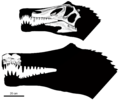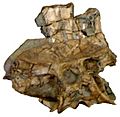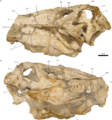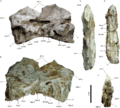Irritator facts for kids
Quick facts for kids IrritatorTemporal range: Lower Cretaceous
|
|
|---|---|
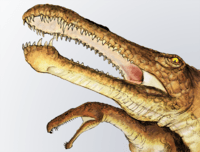 |
|
| Scientific classification | |
| Kingdom: | |
| Phylum: | |
| Class: | |
| Superorder: | |
| Order: | |
| Suborder: | |
| Family: | |
| Genus: |
Irritator
Martill et al., 1996
|
| Species: |
I. challengeri
Martill et al., 1996 (type)
|
Irritator was a type of meat-eating dinosaur called a theropod. It lived a long, long time ago during the Lower Cretaceous period. Its fossils were found in Brazil, in a place called the Santana Formation. Irritator was special because it was the first dinosaur found in Brazil that wasn't a bird!
Contents
Name and Discovery
The scientists who first described Irritator felt quite "irritated" when they saw its fossil. This is because someone had tried to make the dinosaur's snout longer. They wanted it to look like a plesiosaur, which is a different type of ancient sea reptile. This made it harder for the scientists to study the real skull!
The only fossil found so far is an 80-centimeter-long skull. It was found in the Romualdo Member, a part of the Santana Formation. This skull looks a lot like the skulls of other spinosaurids, like Suchomimus and Spinosaurus.
What Did Irritator Look Like?
Irritator was a medium-sized dinosaur. Scientists think it was probably about 8 meters (26 feet) long. That's about the length of a school bus! It had a long, slender jaw with teeth similar to its cousin, Spinosaurus.
Its nostrils were set far back on its snout. This is a good sign that it mostly ate fish. Irritator also had a unique, large crest on the back of its skull.
What Did Irritator Eat?
Scientists believe Irritator mainly ate fish. This is similar to how modern crocodiles eat. Many pterosaurs, which are flying reptiles, were also found in the Santana Formation.
Irritator was probably a generalist eater, like today's crocodiles. This means it ate other animals it could catch, not just fish. A tooth from Irritator was found stuck in a fossil neck bone of a pterosaur. This shows that Irritator ate pterosaurs too. We don't know if it hunted them or just ate their remains.
Irritator and Angaturama
The dinosaur Angaturama lived at the same time and in the same place as Irritator. Many scientists today think that Angaturama might actually be the same dinosaur as Irritator. They believe the fossils belong to the same type of animal.
In 2004, parts of a spinal column were found in the Santana Formation. These bones looked like they belonged to a spinosaurid. It is very likely that these fossils belong to Irritator. This is because Irritator is the best-known spinosaurid found in that area.
Images for kids
-
Map showing the Northeast Region of Brazil, with the discovery sites of three spinosaurine fossil specimens in the Araripe and São Luís-Grajaú Basins marked. From top to bottom: Oxalaia, Irritator, and Angaturama.
-
Outdated reconstruction of the holotype skull (top) based on the interpretations of Martill and colleagues in 1996. Depictions (similar to the one at the bottom) based on this reconstruction were later featured in many dinosaur books and encyclopedias.
-
Known skull elements of Irritator as interpreted by paleontologist Jaime A. Headden; the snout tip is from the Angaturama specimen.
-
Spinosaurine pelvis and sacral vertebrae (specimen MN 4819-V), National Museum of Rio de Janeiro
-
Head of an Indian gharial, which has similarities to the head of Irritator
-
Skeleton mounted as attacking an anhanguerid pterosaur, National Museum of Rio de Janeiro
-
CT scan of the holotype showing endocast and endosseous labyrinth
See also
 In Spanish: Irritator challengeri para niños
In Spanish: Irritator challengeri para niños





